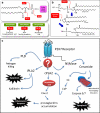Lipid metabolism modulation by the P2X7 receptor in the immune system and during the course of infection: new insights into the old view
- PMID: 21845440
- PMCID: PMC3224635
- DOI: 10.1007/s11302-011-9255-6
Lipid metabolism modulation by the P2X7 receptor in the immune system and during the course of infection: new insights into the old view
Abstract
For decades, scientists have described numerous protein pathways and functions. Much of a protein's function depends on its interactions with different partners, and those partners can change depending on the cell type or system. The P2X7 receptor (P2X7R) is one such multifunctional protein that is related to multiple partners and signaling pathways. The relationship between P2X7R and different enzymes involved in lipid metabolism represents a relatively new field in P2X7R research. This field of research began in epithelial cells and currently includes immune and nervous cells. The P2X7R-lipid metabolism pathway is related to many biological functions of P2X7R, such as cell death and pathogen clearance, and this signaling pathway may be involved in many functions that are dependent on bioactive lipids. In the present review, we will attempt to summarize data related to the P2X7R-lipid metabolism pathway, focusing on signaling pathways and their biological relevance to the immune system and infection.
Figures



Similar articles
-
Structural and Functional Basis for Understanding the Biological Significance of P2X7 Receptor.Int J Mol Sci. 2020 Nov 10;21(22):8454. doi: 10.3390/ijms21228454. Int J Mol Sci. 2020. PMID: 33182829 Free PMC article. Review.
-
P2X7 receptors regulate multiple types of membrane trafficking responses and non-classical secretion pathways.Purinergic Signal. 2009 Jun;5(2):163-73. doi: 10.1007/s11302-009-9132-8. Epub 2009 Feb 3. Purinergic Signal. 2009. PMID: 19189228 Free PMC article.
-
P2X7 Receptor Signaling in Stress and Depression.Int J Mol Sci. 2019 Jun 6;20(11):2778. doi: 10.3390/ijms20112778. Int J Mol Sci. 2019. PMID: 31174279 Free PMC article. Review.
-
P2X7 receptor regulates sympathoexcitatory response in myocardial infarction rats via NF-κB and MAPK pathways.Am J Transl Res. 2017 Nov 15;9(11):4954-4962. eCollection 2017. Am J Transl Res. 2017. Retraction in: Am J Transl Res. 2018 Sep 15;10(9):2996. PMID: 29218093 Free PMC article. Retracted.
-
Effect of P2X7 receptor on tumorigenesis and its pharmacological properties.Biomed Pharmacother. 2020 May;125:109844. doi: 10.1016/j.biopha.2020.109844. Epub 2020 Jan 28. Biomed Pharmacother. 2020. PMID: 32004973 Review.
Cited by
-
ATP/P2X7 receptor signaling as a potential anti-inflammatory target of natural polyphenols.PLoS One. 2018 Sep 24;13(9):e0204229. doi: 10.1371/journal.pone.0204229. eCollection 2018. PLoS One. 2018. PMID: 30248132 Free PMC article.
-
Purinergic signalling and immune cells.Purinergic Signal. 2014 Dec;10(4):529-64. doi: 10.1007/s11302-014-9427-2. Epub 2014 Oct 29. Purinergic Signal. 2014. PMID: 25352330 Free PMC article. Review.
-
Phosphoinositides: tiny lipids with giant impact on cell regulation.Physiol Rev. 2013 Jul;93(3):1019-137. doi: 10.1152/physrev.00028.2012. Physiol Rev. 2013. PMID: 23899561 Free PMC article. Review.
-
Purinergic receptor X7 mediates leptin induced GLUT4 function in stellate cells in nonalcoholic steatohepatitis.Biochim Biophys Acta. 2016 Jan;1862(1):32-45. doi: 10.1016/j.bbadis.2015.10.009. Epub 2015 Oct 22. Biochim Biophys Acta. 2016. PMID: 26474534 Free PMC article.
-
Modulation of P2X7 Receptor during Inflammation in Multiple Sclerosis.Front Immunol. 2017 Nov 15;8:1529. doi: 10.3389/fimmu.2017.01529. eCollection 2017. Front Immunol. 2017. PMID: 29187851 Free PMC article.
References
-
- Mater MK, Thelen AP, Jump DB. Arachidonic acid and PGE2 regulation of hepatic lipogenic gene expression. J Lipid Res. 1999;40(6):1045–1052. - PubMed
-
- Strub GM, Paillard M, Liang J, Gomez L, Allegood JC, Hait NC, Maceyka M, Price MM, Chen Q, Simpson DC, Kordula T, Milstien S, Lesnefsky EJ, Spiegel S. Sphingosine-1-phosphate produced by sphingosine kinase 2 in mitochondria interacts with prohibitin 2 to regulate complex IV assembly and respiration. FASEB J. 2011;25(2):600–612. - PMC - PubMed
-
- Ding R, Han J, Tian Y, Guo R, Ma X (2011) Sphingosine-1-phosphate attenuates lung injury induced by intestinal ischemia/reperfusion in mice: role of inducible nitric-oxide synthase. Inflammation. doi:10.1007/s10753-10011-19301-10750 - PubMed
LinkOut - more resources
Full Text Sources

